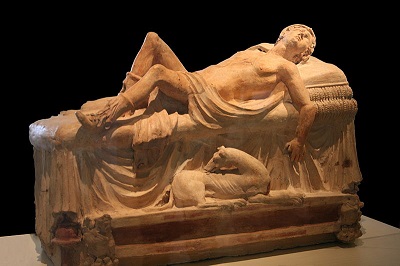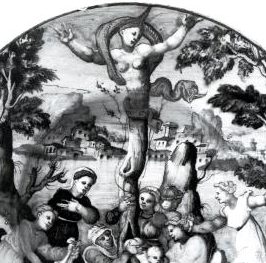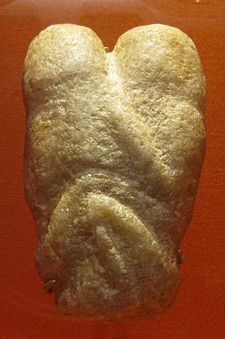|
Adonis

Alias: Atunis
Location: Assyria, Syria, Lebanon, Phoenicia (Palestine), Asia Minor (Turkey), Greece
Cities: Byblos, Athens, Cyprus, Alexandria, Bethlehem
Estimated Date: 800s B.C. - 400s A.D.
He is equated with Tammuz by the Church Fathers
Adonis was equated with Tammuz by Clement of Alexandria, Origen and Jerome. Origen said Tammuz was his real name and that Adonis was his title, “Lord”, just like the Biblical “Adonai”, meaning "Lord", or Adoni-Zedek, king of Jerusalem.
He is a shepherd
He is portrayed like a shepherd by Virgil in the first century B.C., similar to Dumuzi, and a fourth century commentary adds that this was because Adonis was “formerly a shepherd.”
The sheep, too, stand around – they think no shame of us, and think you no shame of the flock, heavenly poet; even fair Adonis fed sheep beside the streams.
-Virgil
Gallus, are not ashamed to stand round thee, so neither do thou be ashamed of them; for even Adonis himself was formerly a shepherd.
-Metellius
He is born from a tree
Adonis is said to have been born from a myrrh tree after his mother Myrrha was turned into one, according to the first or second century author Pseudo-Apollodorus.

His lover is associated with Venus
His lover Aphrodite is equated with the Roman Venus and Dumuzi’s wife Inanna.
He is placed in a box and given to the netherworld
Aphrodite puts Adonis into a chest and gives it to her sister Persephone to help Adonis escape his father, who meant to kill him for being the spawn of incest.
He spends Winter with the Queen of the netherworld and Spring with the fertility goddess
Aphrodite gives the chest to Persephone, the queen of the underworld, but when she opens it, she falls in love with Adonis and refuses to give him back. Very similar to the story of Dumuzi and Inanna, Aphrodite descends into the underworld to get Adonis back, causing Zeus to decree that Adonis would share his time in between Aphrodite and Persephone, representing the turn of the seasons in the same way Dumuzi’s death and rebirth did. The fifth century Roman author, Macrobius, interprets the Adonis myth as a seasonal allegory for life and death, explicitly equating death with the going to Hades and life with being retuning to heaven.
But when Persephone beheld him, she would not give him back. The case being tried before Zeus, the year was divided into three parts, and the god ordained that Adonis should stay by himself for one part of the year, with Persephone for one part, and with Aphrodite for the remainder. However Adonis made over to Aphrodite his own share in addition; but afterwards in hunting he was gored and killed by a boar.
Be thou for ever, my Adonis, mourn'd,
Could Pluto's queen with jealous fury storm,
And Menthe to a fragrant herb transform?
Yet dares not Venus with a change surprise,
And in a flow'r bid her fall'n heroe rise?
“Amongnst the Assyrians and Phoenicians the goddess Venus [Aphrodite] (the upper hemisphere, whilst they call the lower half Proserpine [Persephone]) becomes a mourning goddess, because the sun, passing in the course of the year through the twelve zodiacal signs, comes also in to the lower hemisphere; for they consider six of the signs to be under and six to be above the world. When the sun is in the lower signs, and so the days are shortened, they say the goddess mourns, as though the sun were for a time dead and imprisoned by Proserpine, who represents the divinity of the under half of the circle, and of the antipodes, and they believe that Adonis is given back to Venus when the sun rises into the upper signs with increasing light and length of days. But they say that Adonis was killed by a boar because this beast represents winter.”
Special festival gardens were planted to celebrate the resurrection of life in the Spring and Summer
The festivals celebrated the union of two lovers and many women would also plant “gardens of Adonis”. Plato said the festival in Athens was in midsummer but Pseudo-Lucian places the festival at Byblos in Phoenicia on the vernal equinox (Easter). Although Pseudo-Lucian is third century A.D. or later, Byblos was identified as a cult center for “Damu” (Dumuzi), a “living god”, in the Amarna Letters from the 1300s B.C.
He is worshipped in a mystery cult
Adonis and Aphrodite were worshipped in the Sabazian Mysteries.
Have the luxurious rites of the women glittered
Their libertine show, their drumming tapped out crowds,
The Sabazian Mysteries summoned their mob,
Adonis been wept to death on the terraces…
His death was ritually mourned with wine and he was then proclaimed to live on
During his festival, women drank wine, ritually mourned his death, and then joyfully proclaimed “Adonis continues to live!”
And there the woman, up to the ears in wine,
Was screaming “Weep for Adonis” on the house-top…
Bethlehem had a shrine to him and the town itself may be named after a serpent god who protected his father
Jerome claims that the birth shrine of Jesus in Bethlehem was rededicated to Tammuz-Adonis, but the shrine more likely originated with Tammuz-Adonis since the word Bethlehem means “House of Bread” or “House of Lahmu.” Lahmu is the serpentine gatekeeper of Dumuzi’s father Enki, a role that was typically given to an earlier manifestation of the god himself, just as Dumuzi and Gizzida appear to have some links to ancient serpent gods from the prehsitoric Ubaid era. A 13,000-year-old stone figurine of two lovers embracing, similar to those of Dumuzi and Inanna, was discovered in the Ain Sakhri caves near Bethlehem.

Figurine of two lovers found near Bethlehem dated to 11,000 B.C.
Next God: Attis
The Dying-and-Rising Gods
Leave Comments Here
|

